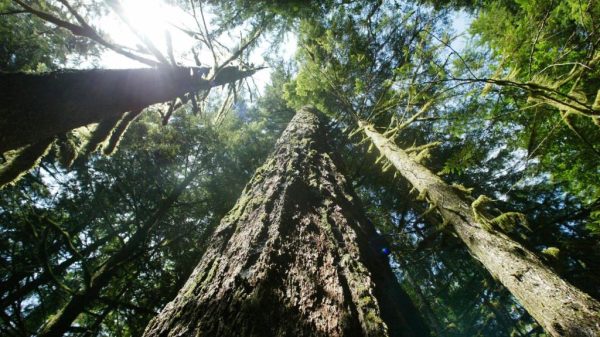Memo to Elon Musk and Vivek Ramaswamy: We can imagine how excited you must be to star in “Honey, I Shrunk the Government!” We suspect you’d frown upon the idea of a brand new agency, sprouting like a delicate green tendril from the federal forest, but we’re here to argue that’s wrong.
If you’re truly interested in governmental efficiency, here’s a no-brainer: Immediately stop the half-century of federal dithering that has let highly radioactive nuclear waste pile up in neighborhoods all over the nation, red and blue alike.

This paralysis has already cost us taxpayers tens of billions of dollars, and will cost us tens of billions more — even if we agree on a solution this very minute.
Think of it: The federal government has already paid nearly $11 billion to the utilities that own these reactors, to cover their unexpected costs for storing and protecting this stuff. That translates to $2 million every single day that there’s no federal repository for nuclear waste!
Millions of pounds of it languish at San Onofre, Diablo Canyon and scores of other commercial nuclear plants all across America, even though the feds were contractually obligated to pick this stuff up for permanent disposal in 1998.
1998!
The paralysis is absurd as well as expensive, but a bipartisan bill recently introduced by U.S. Rep. Mike Levin (D-San Juan Capistrano) and August Pfluger (R-Texas), and co-sponsored by Scott Peters (D-San Diego), proposes a way to change that.

Their plan would also prioritize removing “stranded waste” from shuttered sites like San Onofre, where 3.6 million pounds of highly radioactive spent nuclear fuel squat in an earthquake zone beside the Pacific Ocean close to 8 million people.
If the U.S. wants to triple the amount of nuclear in America by 2050 to help handle increasing energy demands, it’s beyond foolish to consider while we still have no plan for the waste, right?
“I’ve said this ad nauseum, but San Onofre is just the symptom of a far larger problem,” said Levin. “We lack any disposal or repository site, anywhere, and we’ve got an increasing amount of spent nuclear fuel. Particularly if they succeed in increasing nuclear, we have to address the back end of the fuel cycle.”
Singular focus
The Nuclear Waste Administration Act of 2024 would essentially yank all responsibility from the Department of Energy (which has spent more than $10 billion on moribund Yucca Mountain over the decades) and create a new organization, devoted solely to solving the nuclear waste storage and disposal problem.
This was recommended by the Blue Ribbon Commission on America’s Nuclear Future a dozen years ago, and by at least a gazillion experts both before and since. The concept has been hailed by Republicans and Democrats alike.

“It’s about insulating this agency from the political process so it can pursue a long-term strategy that isn’t at risk with every new election,” Levin said.
“Siting and operating a waste facility — this takes decades and requires continuity. You can’t just have, Bill Clinton wants to do this, then George Bush wants to do that, then (Barack) Obama, and (Donald) Trump, and (Joe) Biden and Trump again — it just doesn’t work,” he continued. “The very trust that you need to build to get this done is defeated.”
The other enormous obstacle is funding. Right now, that depends on the DOE’s budget, presidential preferences and Congress’ shifting priorities. It ebbs and flows and must be rehashed and reevaluated and pitted in stiff competition with All The Other Things.
The solution is straightforward in the bill: It would free the new agency from having to constantly scrounge for money by letting it tap the meaty annual interest on the Nuclear Waste Fund’s $47.7 billion piggy bank, which is now off-limits.
That interest totaled a staggering $1.7 billion last year.
What, exactly, is the Nuclear Waste Fund, and how the heck did it get $47.7 billion, you ask? We’ll explain all that in a minute. First, let’s consider what the bill would do.

Ask nicely
Perhaps most important, it incorporates lessons learned from the Yucca Mountain debacle.
Nevada had zero reactors and fought like hell to avoid becoming the nation’s nuclear dumping ground, telling America to take its damned radioactive trash elsewhere, thank you very much. But the federal government proceeded anyway. It was a colossal waste of time and money.
The new bill would require the informed consent of locals before siting repositories. There’d be facts and studies and public meetings and transparency.
Overseeing it all would be an executive appointed by the president and confirmed by the Senate for a six-year term.
There’d be an independent oversight board to keep an eye on spending and progress, also appointed by the president and confirmed by the Senate. It would have five members, and no more than three could be from the same political party.
And it would have a consistent source of funding to keep it on track.
Levin has made nuclear waste a focus of his work in Washington over the past five years, co-chairing the Spent Nuclear Fuel Solutions Caucus with Rep. Chuck Fleischmann, R-Tenn. They’ve helped DOE get the funding to goose a consent-based siting process, and it’s making progress — but there’s only so much DOE can do with the law as it stands. Plus, it has a gazillion other responsibilities.
The new agency would not.

What’s with that $47.7 billion again?
Back to the Nuclear Waste Fund. Back in the last century, when nuclear power was viewed as key to our energy future, the federal government aimed to encourage its development.
Enter the Nuclear Waste Policy Act of 1982, where the feds promised to accept and dispose of commercial waste by Jan. 31, 1998. In return, the customers of the utilities owning these plants would make quarterly payments into the Nuclear Waste Fund to cover disposal costs.
The utilities held up their end of the bargain — pumping about $750 million a year into the fund — while the DOE, sadly, did not. More than 40 years later, the DOE still hasn’t accepted a single ounce of commercial nuclear waste for permanent disposal.
The utilities, unexpectedly stuck babysitting the waste, sued the DOE for breach of contract and won. Along the way, a federal judge concluded that the DOE cannot charge for permanent disposal — a service it not only wasn’t providing, but wouldn’t provide for many decades.
So in 2014, consumers all across America finally stopped paying into the Nuclear Waste Fund. But they probably didn’t much notice. The fee was tiny (about one-tenth of 1 cent for each nuclear-generated kilowatt hour), translating to some 20 cents a month on the average electric bill. But, obviously, it added up. That’s the $47.7 billion.
In the end, it all boils down to this: The federal government is legally responsible for the safe management of spent nuclear fuel, Levin, Pfluger and Peters say in their primer on the bill. The Nuclear Waste Administration Act of 2024 would provide a safe, consent-based pathway to finally get the job done — and eventually stop the bleeding of $2 million a day.
“If you want to get out of a hole,” Levin said, “stop digging.”
Originally Published:

















































